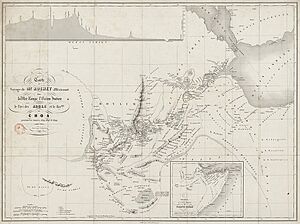Shewa facts for kids
Shewa (Amharic: ሸዋ; Oromo: Shawaa; Somali: Shawa; Arabic: شيوا) is a historical region in Ethiopia. It was once an independent kingdom. Later, it became a province within the Ethiopian Empire. Today, the capital city of Ethiopia, Addis Ababa, is located in the center of Shewa.
Many towns have been the capital of Shewa over time. These include Debre Berhan, Antsokia, Ankober, and Entoto. After Shewa became a province of Ethiopia, Addis Ababa also served as its capital.
Northern Shewa is mostly home to Christian Amharas. This area includes places like Menz, Tegulet, Yifat, Menjar, and Bulga. Southern Shewa is where the Gurages live. Eastern Shewa has many Oromo and Argobba people who follow Islam. The famous Debre Libanos monastery, founded by Saint Tekle Haymanot, is in the Selale district.
Contents
What is the History of Shewa?
Early Beginnings of Shewa
Shewa first appears in history as part of a Muslim state. This state was likely founded around the year 896. Its capital was called Walalah. Recently, French archaeologists found three old city sites in eastern Shewa. One important site, Nora, is believed to be from the former Sultanate of Ifat.
Shewa and the Solomonic Dynasty
Yekuno Amlak started his rebellion against the Zagwe dynasty from a safe place in Shewa. He said his family came from the Solomonic dynasty. These were the old emperors of Axum before the Zagwe rulers. They used Shewa as a safe place when enemies like Gudit threatened them. This is why the region is called "Shewa," which means 'rescue' or 'save'.
The book Kebra Nagast supports this idea. It was written under one of Yekuno Amlak's descendants. The book mentions Shewa as part of the kingdom of Menelik I. Over time, Shewa became part of Abyssinia when the Amhara Solomonic dynasty grew powerful. Emperors like Dawit I and his followers stayed in Fatagar, part of Shewa, for a long time. Shewa was also the birthplace of future emperors Zara Yaqob and Dawit II. Zara Yaqob later made Debre Berhan his capital.
Invasions and Changes
In 1528, Muslim invaders from the Sultanate of Adal attacked Shewa from the east. They destroyed many of its old cities. During the late 16th century, most of Shewa was taken over by the Oromos. Some stories say that Shewa once had a strong king named Sarako. He prevented people from carrying weapons. Then, a giant appeared and defeated Sarako and his family. When the Borana, Gombichu, and Ada clans entered Shewa, no one could stop them.
The Rise of the Shewan Kingdom

The Amhara ruling family of Shewa began in the late 1600s. Negasi Krestos gained control around Yifat. He expanded his land to the south. He took Menz, Tegulet, and Merhabete from the Oromos.
When Sahle Selassie became ruler, he worked with the Abichu Oromo people. He then focused on the Tulama Oromo, defeating them in the early 1820s. After this victory, he rebuilt Debre Berhan, which had been burned in an Oromo attack. He also rebuilt other towns. He made his rule stronger by building fortified villages, like Angolalla. He expanded Shewa's borders into Bulga and Karayu. He also went southeast into Arsi and south into the Gurage lands. After a few years, Sahle Selassie felt strong enough to declare himself Negus, or king, of Shewa. He did this without the permission of the Emperor of Ethiopia in Gondar.
Shewa and Emperor Tewodros II
After Sahle Selassie died in 1847, his son, Haile Melekot, ruled Shewa. Soon, Emperor Tewodros II became interested in Shewa. In October 1855, he moved his army into Shewa. As the Emperor advanced, the Oromo people rebelled and burned Ankober. Haile Melekot decided to burn Debre Berhan to prevent it from falling into Tewodros's hands. He then fled to a nearby hill but died of an illness on November 10.
After Haile Melekot's death, Tewodros's enemies supported the late king's son, Menelik II. Tewodros chased Menelik and captured him. Menelik was then imprisoned in a mountain fortress. After defeating the Amhara people in Shewa, Tewodros focused on the Oromo. It is said that he "exterminated all the Gallas, from Debre Berhan to Ankober."
Menelik II and Addis Ababa
Menelik II escaped from prison in June 1865 when he was 21 years old. He quickly returned to Shewa, which had been damaged by war. In the early part of his rule, he ordered the rebuilding of fortified towns. These included Ankober, Debre Berhan, and Warra Ilu. These towns were in the center of his kingdom. This allowed him to stay in touch with Christians to the south and Muslim Oromos to the northeast. The areas around these towns also had rich pastures for horses and other animals.
After the Egyptian-Ethiopian War, Emperor Yohannes IV was angry that Menelik claimed to be Emperor. Yohannes marched into Shewa and damaged the towns. Menelik realized he could not win and had to submit to Yohannes.
To escape Yohannes's influence, Menelik moved his capital south from Ankober to Mount Entoto in 1884. His wife, Taytu Betul, liked a nearby spring called Finfinne by the local Oromo people. In the spring of 1886, Menelik chose this site for Addis Ababa, his future capital. Building started right away. When Menelik became emperor of all Ethiopia in 1889, Addis Ababa became the country's capital.
Who are Some Famous People from Shewa?
- Meridazmatch and Negus of Shewa (rulers and kings of Shewa)
- People from Addis Ababa
See Also
- List of rulers of Shewa
- North Shewa Zone (Amhara)
- History of Ethiopia



